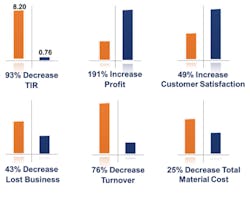SLC 2018: Engaging the Workforce Is a Key to Health & Safety Excellence
Dr. Fulwiler will be presenting a keynote address at EHS Today’s Safety Leadership Conference 2018, “Engagement–The Path to Health & Safety Excellence.” The conference will be held Nov. 6-8 in Louisville, Ky. For more information, go to safetyleadershipconference.com.
The most recent Gallup Poll of the State of the American Workforce, a survey of more than 195,600 workers, found that only 33% are actively engaged, 16% are actively disengaged, and 51% are simply not engaged. Engaged workers are highly involved, enthusiastic and energized about their work and workplace. Not-engaged workers are emotionally unattached to their work or workplace and not energized about their work. Actively disengaged workers tend to be unhappy, resentful and counterproductive.
I found this to be absolutely startling but also a tremendous opportunity to improve not just health and safety results but also other critical business outputs. I first became interested in transformational leadership and the topic of engaging the workforce in 2010 when the Gallup Poll showed 28% engaged, 19% counterproductive and 53% not engaged. Looking at Gallup’s data over the past several years the numbers vary but on average seem to be about 30% engaged, 20% actively disengaged and 50% not engaged.
A 2016 Gallup survey found that engaged workforces had 41% lower absenteeism, 59% lower turnover, 17% higher productivity and 70% fewer safety incidents. The Gallup survey found that, “engaged employees become emotionally and psychologically attached to their work and workplace. As a result, their individual performance soars, and they propel their team and organization to improved crucial outcomes such as higher levels of productivity, safety and quality.” Specific to safety they found, “Engaged workers are more mindful of their surroundings, more aware of the safety procedures and diligent about keeping their coworkers protected.”
Gallup’s comprehensive survey of the workforce presents a convincing argument for increasing the number of engaged workers in the workplace. But how is that accomplished? The simplest answer is getting their heads and heart in the game. This is best accomplished by establishing a mutual self-interest (MSI) between the employee and the employer. This requires a transformation in the leadership of the organization, be it a for-profit or nonprofit, understanding the need to become more transformational and less transactional.
A transactional leader tends to be focused on the output, not those creating the output, while a transformational leader focuses on both the output and those producing the output. In other words, a transformational leader focuses not just on the work but also the worker. Not surprising, senior leadership tends to be skewed to the transactional side of the scale. Enlightened leadership recognizes the importance of becoming more transformational in their leadership style.
It is helpful at this time to say a few words about work systems. I had the privilege to work in a company that saw the importance of putting high-performance work systems in place. A high-performance work system is all about engaging the workforce in the entire work process, including such critical areas as cost, quality, production and safety.
I’ve chosen to simplify the concept of work systems using two simple stick figures, as shown in Figure 1 below. The figure on the left describes a traditional work system that will yield about average or below average results. The worker is not engaged and in fact could be actively disengaged. The figure on the right describes a high-performance work system that will yield well above average to excellent results. What’s the difference? Getting the workers’ head and heart into the game, or in other words getting the workers to become engaged in the work process and/or creating mutual self-interest.
To accomplish this leaders must become more transformational. So let’s take a look at some important characteristics that make a leader more transformational. For the sake of simplicity I have consolidated the myriad of characteristics gleaned from books and literature into five. This provides an excellent starting point for those who want a better understanding of transformational leadership as well as a basis for coaching others to become more transformational. Note how the application of these characteristics create a mutual self-interest between the manager and the employee.
Listening
Most of us have had very little formal training in listening, yet it is one of the most important communication skills. Keys to listening are:
● Seeking first to understand, then to be understood.
● Listening for meaning and feeling, not just facts.
● Being open to the speaker in a way that it shows—being empathetic.
● Not interrupting, hearing the other person out.
Communicating
Communicating means expressing the vision or expectation in a way that resonates with all levels.
● Speaking in the language of the “customer,” i.e., the workers.
● Being open to feedback and even criticism from subordinates.
● Starting meetings with safety to communicate its importance.
Caring
This is the most important characteristic of a transformational leader.
● Demonstrating genuine concern for others in a visible way.
● Being sensitive to the needs of others.
● Being willing to interact with all levels.
Being Collegial
Demonstrating a sense of equality among others, including subordinates. Other keys are:
● Mixing with all levels in a friendly manner.
● Relating to all levels and making them feel at ease.
● Showing gratitude, sympathy, or empathy at all levels.
Engaging
Engaging involves demonstrating a personal connection with subordinates.
● Helping subordinates to commit and achieve the desired goals.
● Linking the workers’ needs with the organization’s needs, i.e., creating mutual self-interest.
● Conveying a sense of worth to subordinates, i.e., they are not just cogs in a wheel.
A Culture of Caring
To validate the premise of this article I will share some real-world data in Figure 2. These data come from a Cintas plant where a new general manager took over who was very transformational and in three years turned the entire business around. He made it clear that this turnaround started with the health and well-being of his employees.
I asked him to explain in simple terms how he accomplished this turnaround. He provided me with this statement which characterizes his transformational vision: “Our (my) vision was to create a culture of CARING. I personally marketed, communicated, demonstrated and taught this message from the moment I began SERVING the partners of Portsmouth.” I added the emphasis to caring and serving since these are the hallmarks of a transformational leader.
Note the dramatic improvement in the safety results: going from a Total Recordable Incident Rate of 8.2 to 0.76 in just three years—truly a move to excellence. But also note the significant improvement in other critical business functions, such as profit, customer satisfaction, turnover and cost. This is why I say that becoming more transformational is not only good for safety but is also good for other critical business outputs. This may be worth sharing with your senior line management.
A Balanced Approach
The concepts and principles of transformational leadership are not new, but they are not well understood and are so poorly executed in many cases. Engagement is the key to achieving any form of functional excellence, and engagement can only be achieved by a management team that demonstrates it truly cares about the health and well-being of their employees, i.e., their mutual self-interest. Being transactional—focusing on regulatory compliance, outputs and numbers—won’t achieve functional excellence or engagement. It takes a balanced approach, which in most cases requires senior management to become more transformational.
Health and safety pros first need to increase their transformational skills and then “coach up” their management on becoming more transformational. Sharing this article with your senior leadership would be a good first step in transforming the organization’s leadership. Good luck!
Dr. Richard D. Fulwiler is president of Transformational Leadership Associates, a consultancy that focuses on organizations achieving functional excellence not just in health & safety but in other critical output areas by applying the principles of transformational leadership. It’s all about getting their head and heart in the game. He also holds a faculty appointment at the Harvard School of Public Health and is co-director of their “Leadership and Management Skills for EHS Professionals” course. Prior to forming Transformational Leadership Associates, he was global director for health & safety at consumer packaged goods manufacturer Procter & Gamble Co. He can be reached at [email protected] or (513) 476-0811.
About the Author
Richard Fulwiler
President
Richard D. Fulwiler, PhD, CIH, CSHM is the president of Transformational Leadership Associates and a course director and instructor at the Harvard School of Public Health. He serves as an adjunct professor of Environmental Health at the University of Cincinnati College of Medicine. Previously Fulwiler was the director of health & safety worldwide for Proctor & Gamble, where he was responsible for safety, industrial hygiene, occupational medicine, OSHA and workers compensation. He is a noted speaker, lecturer and author, and has been named one of “The 50 People Who Most Influenced EHS.”


